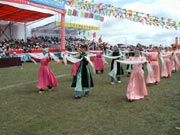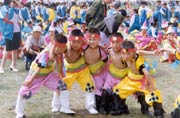|
"Nadam Fair" and "Three Skills of men"
 "Nadam Fair", transliteration of Mongolia language, means "entertainment", or "recreation". Originating in the early days of thirteenth century, it is a festival mass rally of traditional Mongolian. At that time, a big "Huli Letai" (a big meeting) would be hold by leaders of Mongol every month. Many activities were taken on during the meeting, such as making laws and regulations, appointing and removing officials, giving prize and penalty. Besides, a large "Nadam Fair" would also be hold. At that time, Nadam mainly refers to wrestling, horse racing and archery. After Qing Dynasty, Nadam was always held in league, banner or Sumu unit every half, or every one or two years. Winners of the three sports would be given horses, camels, sheep, brick tea, and silk as awards. However, its content and form has changed greatly after the liberation. Besides the traditional sports game--- wrestling, horse racing and archery, which was called "three skills by men", the content was enlarged by many new activities, such as theatrical perform, movies, material exchange. The newly added contents pushed the traditional national grand meeting to a joyous, auspicious, happy and effective one. Nowadays, Nadame is always hold in the golden autumn or summer that herds of sheep and cattle are thriving and it is often lasts for three or seven days. Whenever this time, herdsman will converged from all directions in complete-new national costume, riding their horses, carrying yurt and all kinds of meat and milk food on their light wooden cart. While putting up the yurt on the greensward, people begin to simmer tea and stew meat. While Smoke curling upward from kitchen chimneys on the whole grassland, all the people will be absorbed in a joyous atmosphere. "Nadam Fair", transliteration of Mongolia language, means "entertainment", or "recreation". Originating in the early days of thirteenth century, it is a festival mass rally of traditional Mongolian. At that time, a big "Huli Letai" (a big meeting) would be hold by leaders of Mongol every month. Many activities were taken on during the meeting, such as making laws and regulations, appointing and removing officials, giving prize and penalty. Besides, a large "Nadam Fair" would also be hold. At that time, Nadam mainly refers to wrestling, horse racing and archery. After Qing Dynasty, Nadam was always held in league, banner or Sumu unit every half, or every one or two years. Winners of the three sports would be given horses, camels, sheep, brick tea, and silk as awards. However, its content and form has changed greatly after the liberation. Besides the traditional sports game--- wrestling, horse racing and archery, which was called "three skills by men", the content was enlarged by many new activities, such as theatrical perform, movies, material exchange. The newly added contents pushed the traditional national grand meeting to a joyous, auspicious, happy and effective one. Nowadays, Nadame is always hold in the golden autumn or summer that herds of sheep and cattle are thriving and it is often lasts for three or seven days. Whenever this time, herdsman will converged from all directions in complete-new national costume, riding their horses, carrying yurt and all kinds of meat and milk food on their light wooden cart. While putting up the yurt on the greensward, people begin to simmer tea and stew meat. While Smoke curling upward from kitchen chimneys on the whole grassland, all the people will be absorbed in a joyous atmosphere.
 
From ancient times, the "Three skills by men"--- wrestling, horse racing, archery--- are the three skills that man should have a good command of and also they are treated as the standards to judge whether one acquire the capability. Such sports can be carried through at any time and everywhere, since special field, any specified equipment or a fixed number of people are not necessary. Therefore, the three skills are not only the major content of Nadam Fair includes, but also held very often among the people on happy event or occasions, such as in the spare time of working, marriage, and festivals.
Mongolian way of wrestling is different from both the Chinese wrestling and the sumo wrestling in Japan. It distinguishes from other ways by its own rules, methods, uniforms and fields. The rules and methods for wrestling is: there is neither a separation of grade (no age and weight distinction) nor a fixed number--- as long as even numbers as two, four, six, eight, sixteen, thirty-two, sixty-four or one hundred and twenty-eight will do. All the wrestlers are matched by the arrangement or by drawing cuts, which are charged by the judges who enjoy high prestige and command universal respect. The game adopted single- elimination rules that victory or defeat is determined once. The looser is not allowed to compete again. Half of the people will be eliminated every time. As soon as the judge gives an order to start, the opponents first shake hands to show respect to each other, and then begin to wrestling. There is no limitation of time and the opponents can freely choose any ways or skills, such as tick, pull, kick, trip, push, hold, lift, etc. however, it is not allowed to wrestle with holding the other's legs, nor kick arbitrarily, nor pull the other's trousers. The person whose any part above knees that touch the ground is the looser. There is a special uniform for wrestlers. Made of cowhide or canvas, a Tight half sleeves jacket called "Zhao de ge" is for the upper part of the body, whereas a pair of loose wrestling trousers for the lower part of the body. With a pair of Mongolian boot on foot, colorful cloth chaplet is worn around the neck. The field for wrestling is very brief. An area of lawn or soft space is all right, where audience can sit around on the ground and wrestlers face each other in the middle. Before the wrestling start, a challenging song will be sung in order to build up momentum and power by the person of each side. Moreover, whenever wrestlers enter or exit the wrestling ground, they have to imitate the action of a tercel, which is jump to go forward full of power and grandeur.
Horse racing of Mongol can generally be divided into two: walking race and galloping. In Walking horse racing, horses are competing for the speed, resistance, steadiness and beauty by letting the horse to run with versus side steps (the front hoofs and hind hoofs take turns to run). The horses for racing are generally older than five years and the riders are always adults. The race require a highly lofty horsemanship so that the rider is able to rein the horse to walk steady, beautiful and as fast as possible, but rather than running. Galloping mainly tests the horses' speed and resistance. Therefore, the winner is the first one who reaches the terminal line. The stepping way of galloping is quite different from the pace in the walking race. The four hoofs should run by taking dual-turns. Most of The riders are male and the children around twelve or thirteen take a major part, for they generally have a nimble and fast body. Galloping horses usually do not equipped with saddle or only with a light and handy saddle, for sake of lightening the load of the horse as well as the safety of the rider. Magnificent colorful uniforms will be taken on and a red ribbon tied around the rider's head, as to show the riders' soldierly air and manner. The distance of the race usually covers twenty-five to thirty-five kilometers. As galloping horse racing is more common and widespread than the walking race, more people take part in the game, from tens to hundreds. As soon as the race starts, riders mount their horses as soon as possible and raise whips to speed. Meanwhile, the audiences shout and jump for joy and encouragement for the riders. According to the Mongolian convention, horse praising should be taken on after the race is over. Horses that acquire place in the race all ranked in front of the platform by sequence and then they are to be commended by praising words that are recited and sung by senior citizens of high prestige. Afterwards, they will split kumiss or fresh milk to the horse that won the first place, showing blessing. Except for the traditional ways of horse racing, new types of horse racing come forth in recent years, such as obstacle race, figure race, which enrich and improve this sport to a more wonderful one.
Archery has two types--- to shoot arrow statically and while riding. The arrow's pattern, weight, length or pulling force can be chosen freely without any limitation. Generally, each one has nine arrows to shoot by three turns and the result depends on the numbers of arrows that hit the target. To shoot statically means to draw a bow to shoot while standing still. The distance from the target to the archer is in accordance with specific conditions, but it is usually fixed in the same competition. To shoot while riding is to draw a bow and shoot while riding a horse galloping in a special track. Generally, the track is a special channel that is four meter wide, eighty-five meter long and half a meter in depth. There are two targets standing on the left side while one on the right. In the competition, entering the track on horse back, drawing a bow while the horse speeding up, the archer aim at the target to shoot at his best.
The mass sports activities such as wrestling, horse racing and archery play the very important role in both physical training and enrichment of amateur culture life. The more important thing is that, numbers of excellent athletes are cultivated in Inner Mongolian Autonomous Region and Xinjiang Uygur Autonomous Region. Mongolian athletes are always the winners in many competitions in the country, as well as some international matches, wining honor for the Chinese nation.
Horse, Camel & Light wooden cart
<<
The story of MaTou Qin
>>
|

